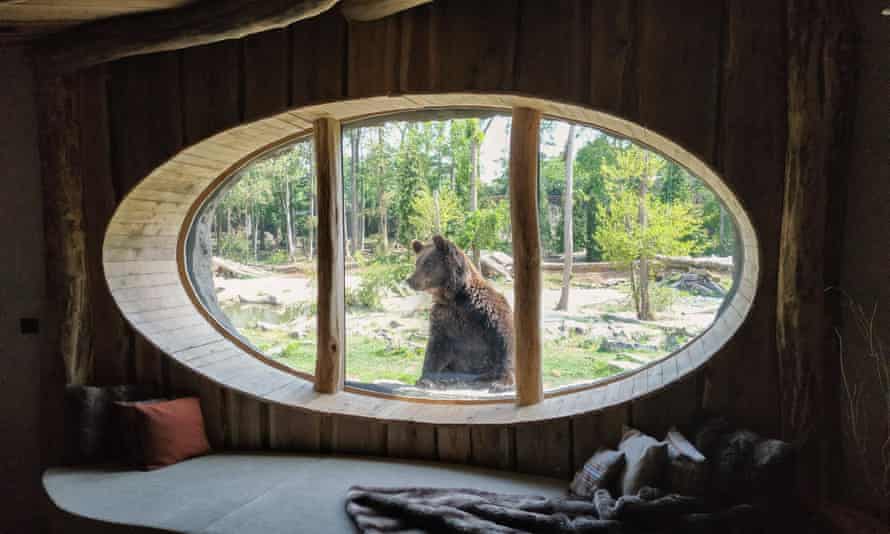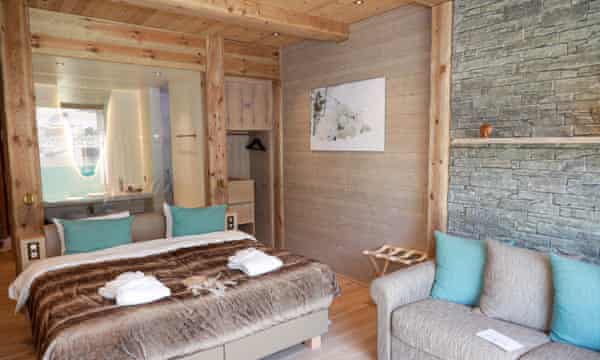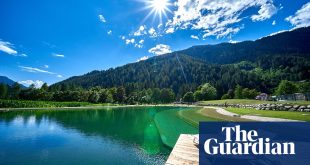Polar bears snore. Perhaps not all of them, but certainly the hulking beast that slept near me, my wife, Nicola, and our two young children. Deep, growly exhalations, not dissimilar to my own, I was cheerfully informed by George, nine, and Lottie, seven.
The nocturnal habits of the world’s largest land-living carnivore were revealed to us during a stay over at Pairi Daiza (Persian for paradise), a peculiarly beautiful zoo and botanical gardens in a most implausible location: deepest Wallonia, the Francophone and economically struggling region of southern Belgium.
Founded in 1993 as a humble bird sanctuary around the remnants of a 12th-century Cistercian abbey and a neighbouring stately home, today Pairi Daiza is home to 7,000 animals, along with the largest Chinese and Indonesian gardens in Europe, spread across 65 hectares (160 acres) of picture-perfect landscape.

To put this in context, London zoo houses 16,000 animals on just 15 hectares on the edge of Regent’s Park. Pairi Daiza, voted Europe’s top zoo for the past three years by the Diamond Theme Park awards, the Oscars of the zoological world, is vast and ever-expanding.
It was the park’s latest growth spurt into the Belgian countryside in the municipality of Brugelette, an hour’s drive from Brussels, that offered the opportunity for us to hear a polar bear’s nightly snorts.

Two years ago, in recognition that its sheer size makes it difficult for even the most sprightly of wildlife spotters to cover in a day, let alone a young family, Pairi Daiza opened 50 rooms with views of the bears, wolves, deer and seals.
Last year they went further. A new section of the zoo, entitled the Land of the Cold, was opened, complete with a further 50 bedrooms sharing glass walls with the polar bears, walruses, penguins and Siberian tigers.
The new high-spec accommodation includes sub-aquatic rooms, so you can watch water-dwelling animals swim underwater and feed, all from the comfort of your bed, or indeed your own whirlpool bath.
The rooms are not recommended for those who fancy a lazy start to their day, although the polar bears were courteous enough to keep their roars around us to a minimum. We experienced the snoring during a rather eerie walk, late at night, back from one of the zoo’s restaurants. But the new “immersive” accommodation has proven immensely popular, and it is easy to see why in a setting like this.
Pairi Daiza is the “childhood dream come true” of former lawyer and financial consultant Eric Domb, 61, who is obsessive enough about the place to live in it, and keep a treehouse holiday home for himself among the red pandas.
Domb is, to put it mildly, a collector. His favourite animal is said to be the elephant. The zoo has 23 – two African and 21 Asian – the largest herd in Europe. He also has a fascination with China: he travelled to Shanghai and brought over a team of landscapers to help build his Middle Kingdom world – home to five giant pandas – and Chinese garden, full of pink and purple flowering azaleas, camellias and maples. Visitors are advised that it is best enjoyed barefoot.
On a trip to Vancouver, Domb spotted a Twin Beech seaplane that he thought would inspire his guests. After multiple stops, the plane arrived in 2015 at Lac de la Plate Taille, south of Charleroi, the only water surface in Belgium big enough for the landing, before being transported to sit alongside the zoo’s lake, where it is a cause of curiosity for both the visitors and the harbour seals that live in that part of the zoo. Like many theme parks, Pairi Daiza has a train encircling it, but this one is run by a fully functioning, early-20th-century steam engine salvaged from Poland that whistles along at a pace just on the right side of alarming.
Zoos need to work hard to justify their existence, and the image of an eccentric Belgian collecting baubles from around the world for a European audience could be offputting to some. I arrived as a zoo-sceptic, and my son wanted to know where the animals had been taken from. But the stated purpose of Pairi Daiza is to save species from extinction and introduce them into the wild if possible, while seeking to educate visitors about the wider culture of the lands the animals originate from – and why all of that matters.

The zoo has been a member of the European Association of Zoos and Aquariums since 1994, coordinating breeding programmes for endangered species to ensure a healthy gene pool. There are fewer than 26,000 polar bears in the wild, with numbers diminishing quickly as their sea-ice habitat shrinks. Pairi Daiza is currently introducing two males and two females. The NGO Polar Bear International has granted the zoo “ambassador” status in recognition of its efforts. Scientific programmes include finding a cure for elephant herpes and inventing a pregnancy test for pandas.
It is also a place of refuge. Two underweight walruses recently arrived from a zoo in St Petersburg that closed during the pandemic, and they are now doing well. This autumn, the local media was full of a story about a stowaway racoon offered a home after being found onboard the Dutch freighter Singelgracht on its return from a trip to Baltimore. Last year, 477 turtles, snakes, lizards and caiman crocodiles, discovered by border control or left abandoned by owners, were taken in by the zoo’s Mersus Emergo, a former whaling ship anchored by the lake as accommodation for the park’s reptiles and amphibians.

There is no set route around the park – guests are encouraged to get a little lost, find something new. Waterways or steep landscapes are used wherever possible as a means to parcel off enclosures. As we arrived, and a flock of pelicans soared overhead, my first impression was of something akin to Jurassic Park, albeit with a brewery and a replica wood-framed Taoist temple that serves Chinese food, as two of nine catering outlets.
As part of the accommodation package, visitors have two full days of access to the park, which we fully exploited. But we will have to return. There was simply too much we did not have time to see or, indeed, hear. I wonder if Siberian tigers snore?
The trip was provided by Pairi Daiza: Le Jardin des Mondes. A one-night stay for a family of four in a room overlooking the sea lions costs from €373, including half-board and unlimited entry to the zoo over two days. A sub-aquatic room close to the polar bears costs from €630
 Top Naija News: Nigerian News, Breaking News Nigeria and World News Top Naija News is a daily news publication in Nigeria, delivering the latest breaking news in Nigeria and around the world.
Top Naija News: Nigerian News, Breaking News Nigeria and World News Top Naija News is a daily news publication in Nigeria, delivering the latest breaking news in Nigeria and around the world.



